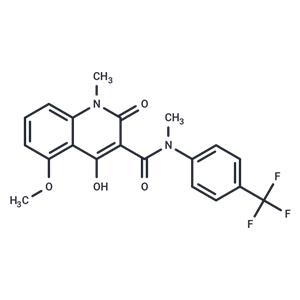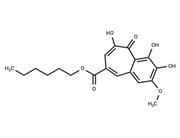| Name | Tasquinimod |
| Description | Tasquinimod (ABR-215050) is an oral antiangiogenic agent with potential antitumor activity. It is also an S100A9 inhibitor and binds to the HDAC4Zn2+ binding structural domain with Kd values between 10 and 30 nM. |
| Cell Research | Tasquinimod is dissolved in DMSO and stored, and then diluted with appropriate media before use[3]. Two human prostate cancer cell lines, CWR-22RH and LNCaP (ATCC) are both androgen independent, but remain sensitive to androgen stimulation of growth, express PSA and a mutated androgen receptor. The hormone independent cell lines LNCaP19 and DU145 are also tested for TSP1 induction after in vitro exposure to Tasquinimod (0.1-100 μM). CWR-22RH, LNCaP and DU145 are grown in RPMI Medium 1640 containing 10% FCS and L-Glutamine mixture, while LNCAP19 is cultured in RPMI-medium with 10% hormone free (RDCC) FCS[3]. |
| In vitro | METHODS: Human MM cells (multiple myeloma cells) were treated with increasing concentrations of Tasquinimod (ABR-215050) (10,25 μM) for 24 h, 48 h, 72 h, and 120 h. The effect of Tasquinimod on the value added of human MM cells was observed.
RESULTS Tasquinimod inhibited the growth and proliferation of MM cells in vitro. [1]
METHODS: SKOV3 and SKOV3/DDP cells were treated with 40 μM tasquinimod, and the expression of histone deacetylase 4 (HDAC4), Nur77, Bcl-2 (BH3 structural domain specific), and caspase-3 were analyzed by Western blot and quantitative real-time polymerase chain reaction (qPCR).
RESULTS Cell migration and HDAC4 expression levels were significantly reduced, while Nur77 expression levels were elevated. [2] |
| In vivo | METHODS: Mice were treated with Tasquinimod (ABR-215050) (30 mg/kg), added to the daily drinking water at an early stage after MM cell inoculation, and immune cell populations were studied using flow cytometry.
RESULTS Short-term Tasquinimod treatment did not lead to alterations in MM cell homing to the bone marrow, but a significant increase in the total percentage of CD11b cells could be observed, whereas a slight decrease in monocytes and immature myeloid populations (CD11b, Ly6G, Ly6C+-low) was observed, and an increase in macrophage populations (CD11b, F4/80), which showed a more pro-inflammatory phenotype of M1 (MHCII) and the M2 marker CD206.[1]
METHODS: SKOV3 or SKOV3/DDP cells were injected into 4-week-old female BALB/c nude mice. Then, 50 mg/kg Tasquinimod was administered every 3 days. finally, changes in tumor diameter and weight were measured, and apoptosis, migration rate, and related expression of Nur77 and Bcl-2 (BH3 structural domain specific) were detected by flow cytometry, scratch assay, and immunofluorescence.
RESULTS Tasquinimod significantly reduced tumor diameter, tumor mass, and in vivo HDAC4 levels in mice. Meanwhile, Nur77 and Bcl-2 (BH3 structural domain specific) levels were elevated. [2] |
| Storage | Powder: -20°C for 3 years | In solvent: -80°C for 1 year | Shipping with blue ice. |
| Solubility Information | Ethanol : 9 mg/mL (22.1 mM)
DMSO : 65 mg/mL (159.96 mM), Sonication is recommended.
H2O : < 1 mg/mL (insoluble or slightly soluble)
|
| Keywords | ABR 215050 | Inhibitor | inhibit | Tasquinimod | Histone deacetylases | HDAC | ABR215050 |
| Inhibitors Related | Valproic acid sodium salt | Panobinostat | Theophylline monohydrate | Sodium 4-phenylbutyrate | Vorinostat | Acefylline | Curcumin | Valproic Acid | 4-Phenylbutyric acid | Theophylline |
| Related Compound Libraries | NF-κB Signaling Compound Library | Bioactive Compound Library | Chromatin Modification Compound Library | Anti-Cancer Clinical Compound Library | Drug Repurposing Compound Library | Inhibitor Library | Anti-Aging Compound Library | Bioactive Compounds Library Max | Anti-Cancer Drug Library | Anti-Cancer Active Compound Library |

 United States
United States



